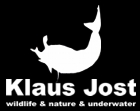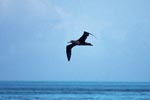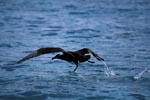Apps (iPhone, iPad & iPod):
![]() great white shark
great white shark
![]() sharks
sharks
![]() seabirds
seabirds
Scientific shark articles
Alaska & Wildlife
Arctis
Birds
Cities
Egypt - Land of the Nile
Fauna & Flora Fiji
Fiji sharkproject
Mountains
Nature
Penguins & seals
Polar bear
Sea
Seabirds
Southern Right Whale
Underwater
Wildlife South Africa
Photos of the Black footed albatross (Diomedea nigripes) on the open sea, swimming, on the water starting and flying over the Midway Atoll, Hawaii.
1,200 miles north-west of Honolulu, 2,800 west of San Francisco and 2,200 miles from Japan, the Midway Atoll rises from the Pacific – just made for sea birds and especially for albatrosses. During my stay in July 2001 I was able to watch and take photos of these legendary birds during their intensive preparation for their big journey to the endless ocean. There exist 14 albatross species worldwide, but only three of them are found on the Midway Atoll. The largest breeding colony of the Laysan Albatrosses (Diomedea immutabilis) and the second largest of the Black-footed Albatrosses (Diomedea nigripes) is located here. Approximately 400,000 Laysan and 18,000 Black-footed Albatross pairs are on the islands between the end of October and July. Every year, a Short-tailed Albatross (Diomedea albatrus), whose natural habitat is originally the Japanese island of Torishima, comes to the island as well. Albatross parents fly far out to sea to find food for the chick, mainly octopus. In July, the young birds are fledged and are busy practising starting and landing. They need to be very careful not to fall into the water while trying to fly. If in such a case they do not manage to start again immediately successfully, their feathers saturate with water and the danger of drowning is great. But the first try to fly out to sea should also be absolutely successfulfor another reason: exactly at this time of the year, Tiger Sharks meet at the “strategically correct“ place and wait for an albatross forced to land on the water. However, if the start was successful, they glide over the sea for several years until they come back to Midway for breeding. Albatrosses are flying artists and storm is their element. They feel extremely well with gales and towering waves. With their narrow and extremely long wings they sail over the ocean flap of wings without a in hours. Laysan Albatrosses have a wingspread of 2.1 metres and a weight of 2.4 kilograms. Albatrosses spend 90 percent of their lives in the air. The birds’ flight and navigation performance is enormous: an albatross with a small transmitter covered a distance of 40,000 kilometres in 90 days. Albatrosses find their home island to which they return for breeding from every point on the earth. But their return is uncertain, because there are dangers against which the albatrosses have no chance. Many Laysan and Black-footed Albatrosses die from the hooks of the long-line fishery. There are lines with a length of more than 100 kilometres with more than 20,000 hooks to which the fish baits are attached. As soon as the lines are let down from the boat into the water, the birds try to catch the easy prey. Often they get caught in the hooks and drown as soon as the line falls down through their weight. Discarded plastic rubbish represents another danger. On Eastern Island a biologist showed to me the contents of the stomachs of several dead albatross chicks. One could see an incredible accumulation of the most different plastic products. The albatrosses find this garbage everywhere on the sea, they swallow it and feed these plastic pieces to their chicks, often with fatal consequences. Also chemical waste such as PCBs and dioxins– existing even in the most remote places in the sea– represent an enormous danger to the albatrosses. Albatrosses are threatened by extinction.Diomedea nigripes
IUCN Red List of Threatened Species









